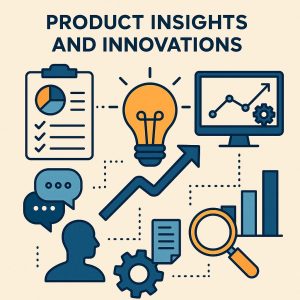 In today’s competitive marketplace, product insights and innovations are essential drivers of business growth and differentiation. Product insights refer to a deep understanding of customer needs, behaviors, preferences, and pain points derived from data analysis, market research, and user feedback. Innovations, on the other hand, are the creative and practical applications of these insights to develop new or improved products that deliver superior value.
In today’s competitive marketplace, product insights and innovations are essential drivers of business growth and differentiation. Product insights refer to a deep understanding of customer needs, behaviors, preferences, and pain points derived from data analysis, market research, and user feedback. Innovations, on the other hand, are the creative and practical applications of these insights to develop new or improved products that deliver superior value.
Successful product innovation begins with customer-centricity. Companies that listen carefully to their users are better positioned to identify gaps in the market or inefficiencies in current offerings. Tools such as customer journey mapping, surveys, social listening, and user interviews help gather qualitative and quantitative data. From these inputs, product managers and designers can uncover unmet needs or latent desires that may not be immediately obvious.
Once insights are gathered, the innovation process involves ideation, prototyping, testing, and iteration. Design thinking is a popular framework used to encourage empathetic and iterative development. It involves five stages: empathize, define, ideate, prototype, and test. By cycling through these stages, teams can rapidly develop and refine product concepts that align closely with customer expectations.
Technological advancements have significantly expanded the possibilities for product innovation. Artificial intelligence (AI), machine learning (ML), the Internet of Things (IoT), augmented reality (AR), and blockchain are enabling entirely new categories of products and services. For example, AI-powered recommendation engines are transforming e-commerce experiences by personalizing product suggestions. Similarly, wearable fitness devices with IoT connectivity allow users to monitor their health in real-time, fostering proactive wellness habits.
Another key trend in product innovation is sustainability. Consumers are increasingly demanding eco-friendly products that reduce environmental impact. This has led companies to rethink materials, packaging, manufacturing processes, and lifecycle impacts. Brands that successfully integrate sustainability into their product strategy often benefit from enhanced customer loyalty and brand equity.
Agile development methodologies also play a critical role in accelerating innovation. Unlike traditional waterfall approaches, agile enables teams to release minimum viable products (MVPs) quickly, gather feedback, and make continuous improvements. This responsiveness allows businesses to stay ahead of changing market conditions and customer expectations.
Data-driven decision-making has become a cornerstone of modern product development. Advanced analytics tools allow businesses to measure product usage, feature adoption, churn rates, and user satisfaction in real time. These insights enable teams to prioritize improvements, optimize user experiences, and make informed roadmap decisions.
Cross-functional collaboration is another essential element. Product innovation thrives when diverse teams—spanning design, engineering, marketing, and customer support—work together. This synergy fosters creative solutions and ensures that products are not only technically feasible but also marketable and user-friendly.
In conclusion, product insights and innovations are vital for creating meaningful, competitive, and sustainable products. By grounding innovation in real user needs and leveraging modern technology and agile processes, organizations can continuously deliver value to their customers and maintain a competitive edge in the market.






